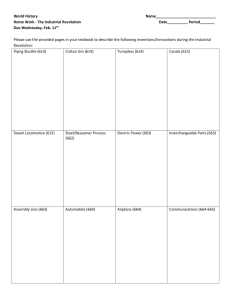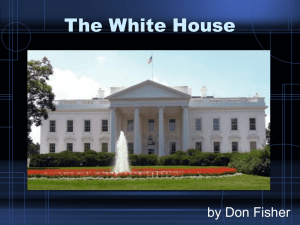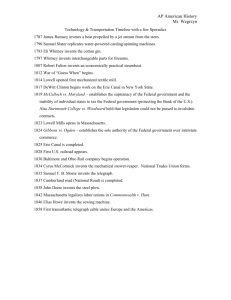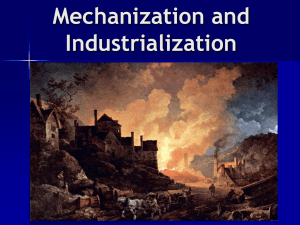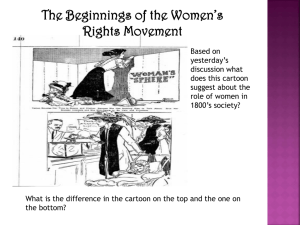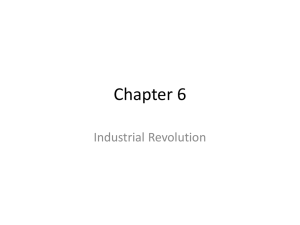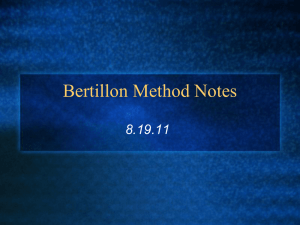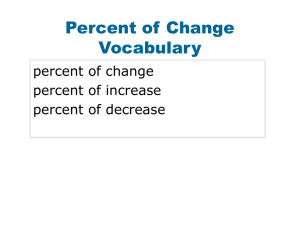Ch 21 The Second Industrial Revolution PPT
advertisement
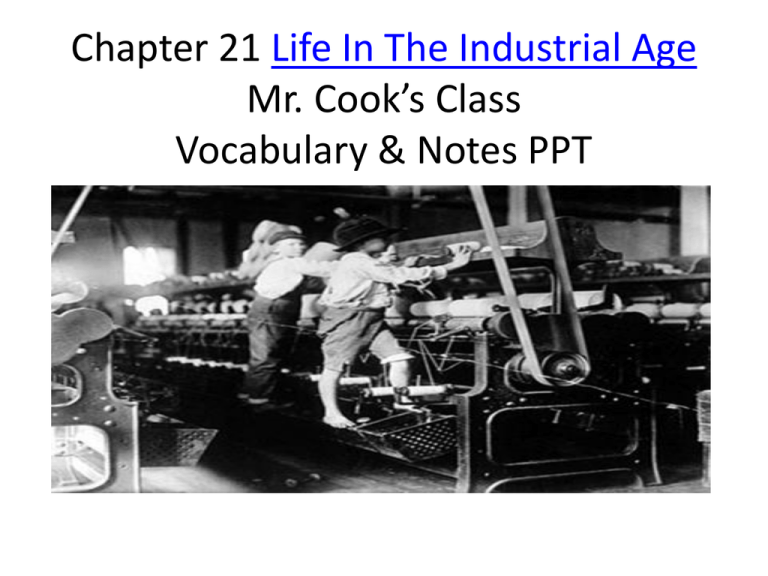
Chapter 21 Life In The Industrial Age Mr. Cook’s Class Vocabulary & Notes PPT Henry Bessemer • Develops the Bessemer process • New way to make steel from iron • 1856 Bessemer patents steel which was lighter, harder, and more durable than iron • Steelmaking process Alfred Nobel • 1866 invents dynamite • Much safer explosive than had been invented to that time • Used in warfare and peace • Awards funded by Nobel’s profits to this day Michael Faraday • Invents the first simple electric motor and dynamo • All electrical generators and transformers work on the principle of the dynamo dynamo • A machine that generated electricity Thomas Edison • 1870’s invents the first electric light bulb • Invents the power plant which he uses to light NYC for the first time in the 1780’s • Leads to society which has electrical wires carrying power everywhere Interchangeable parts • Invented by Eli Whitney while making parts for U.S. Army gun order • Allows identical components to be created for easy assembly and repair of products Assembly line • Workers along a line add parts to a product as it goes by on a belt from one station to the next • Makes production faster by the early 1900’s • Henry Ford “perfects” the process in order to produce cars Orville & Wilbur Wright • 1903, these two gentlemen design and fly a flimsy airplane at Kitty Hawk, North Carolina • Flight lasts only a few seconds • Commercial travel begins by the 1920’s • Inventions Guglielmo Marconi • By the 1890’s, Marconi invented the radio • By 1901, he had received a radio message, using Morse code, sent from Britain to Canada stock • Shares in companies (part or piece of ownership of a company) • Due to large amounts of capital required to start large industries, selling stock becomes necessary as industries grew corporation • Giant businesses that are owned by many “stock holders” or investors • Corporations could expand into many different venues with lots of capital cartel • Group of corporations joining forces to fix prices, set production quotas, and control markets • Growth of monopolies occurs Growth of Cities Notes London Fog Germ theory • Belief originating in the 1600’s that microscopic organisms or microbes caused specific infectious diseases Louis Pastor • 1870, French chemist who clearly demonstrated a link between microbes and disease • Also develops vaccines against rabies and anthrax • Discovered pasteurization which kills disease carrying microbes in milk Robert Koch • 1880’s, German doctor who identified the bacterium that caused tuberculosis • Tuberculosis- respiratory disease that claimed about 30 million lives in the 1800’s Florence Nightingale • Crimean War nurse who insisted on better hygiene in field hospitals • Also worked to introduce sanitary measures in British hospitals • Founded the first school of nursing Joseph Lister • English surgeon who discovered how antiseptics prevented infection • Insisted surgeons sterilize their instruments and wash their hands before operating Urban renewal • Rebuilding of the poor areas of a city • Trend in Europe in the mid-1800’s Mutual-aid society • Self-help groups formed to aid sick or injured workers • Revolutions of 1830 and 1848 left lasting images of worker discontent • Rise of workers Standard of living • The quality and availability of necessities and comforts in a society • Workers lives improve with better diets, homes, clothing, etc. Cult of domesticity • Ideas by the late 1800’s that women were tied to the home • Poor women still had to work and be the home caretaker • “Home, Sweet Home” Temperance movement • A campaign to limit the use of alcoholic beverages • Leads indirectly to the women’s rights movement in the United States • 1820’s-1920’s Elizabeth Cady Stanton • Pioneer who started movements to gain more rights for women • 1848 Seneca Falls Convention • Movement comes out of the abolitionist movement of the 1830’s-1860’s • Women’s Suffrage Women’s suffrage • The movement to gain women’s right to vote begins in Seneca Falls in 1848 • By late 1800’s, movement has spread to Europe Sojourner Truth • African American women’s suffragist • Claimed that she did not receive many of the “comforts” of womanhood because she was black John Dalton • Early 1800’s, English Quaker schoolteacher develops modern atomic theory • All matter is created of tiny particles called atoms • Different kinds/combinations of atoms make different matter Charles Darwin • In 1859, On the Origin of Species was published • Believed all forms of life had evolved into their present state over millions of years • Natural selection- process of competition allows only the fittest to survive • HMS Beagle racism • One racial group is superior to another Social gospel • Pushed by Christians to encourage social service • Including working for reforms in housing, healthcare, and education romanticism • Artistic style emphasizing imagination, freedom, and emotion • Works focus on simple, direct language, intense feelings, and glorification of nature • Romantic authors included William Wordsworth and William Blake • Sunset Lord Byron • Britain’s George Gordon • Writer of poetry and adventures that died early • Wrote mostly of isolated romantic heroes Victor Hugo • Re-creates France’s past in the Hunchback of Notre Dame and Les Miserables • Les Miserables describes the reality of poverty, hunger, and corruption among the poor in Paris Ludwig van Beethoven • Romantic composer (1770-1827) who composed nine symphonies, five piano concertos, etc. • Lost his hearing at an early age but still continued to compose realism • By mid-1800’s, new movement to attempt to represent the world as it was • Often focused on life in cities or villages • Harsh truths were revealed • Artistic movements Charles Dickens • English novelist who portrayed the lives of slum dwellers and factory workers, including children • Oliver Twist and A Christmas Carol illustrate lives of those less fortunate in late 1800’s London Gustave Courbet • French realist painter who focused on real life subjects • “I cannot paint an angel… because I have never seen one” • The Stone Breakers- painting showing two rough laborers on a country road Louis Daguerre • French photographer who first produced successful photographs in the 1840’s impressionism • Movement in the 1870’s to represent the first fleeting impression made by a scene or an object • Why paint realism when a photograph could capture it in an instant? Claude Monet • Famous impressionist painter who left unblended brush strokes side by side in paintings • Allowed human mind/eye to blend the colors in paintings Vincent van Gogh • Postimpressionist artist who experimented with sharp brush lines and bright colors • His brushwork gave a dreamlike quality to his paintings Back to Title Back to Wright Brothers Back to cartels Back to Urban Renewal Back to Standard of Living Back to Women’s Suffrage Back to Courbet Back to Charles Dickens
